2023 Zero DSR/X Review - First Ride

Zero's most advanced motorcycle yet, built specifically for the ADV market.
The thing about any of the electric motorcycle companies actually taking product development seriously is that, more often than not, each new model they introduce is markedly better than any model before it. Considering the EV market is still in its early stages, you expect a marked advancement with each new model.
2023 Zero DSR/X
Editor Score: 85%
| Engine | 19/20 | Suspension | 13/15 | Transmission | 10/10 |
| Brakes | 8.5/10 | Instruments | 4.5/5 | Ergonomics | 9/10 |
| Appearance | 9/10 | Desirability | 7/10 | Value | 5/10 |
+ Highs
- Instant torque
- Amazingly linear power delivery
- Spacious built-in storage
– Sighs
- It ain’t cheap
- ADV purists probably won’t accept it
- Range anxiety out in the woods is very real
Sometimes, however, an OEM can even outdo itself. This is where we find ourselves with Zero’s newest model, the 2023 Zero DSR/X. It’s fitting to see Zero capitalizing on the booming popularity of the adventure bike market. Everyone’s doing it these days, but when you pause to take a step back at the greater motorcycle landscape, the ADV category has supplanted sportbikes as the new arena in which motorcycle manufacturers – no matter what method of propulsion is used – develop and implement the latest tech. It’s where engineers can really go wild. In Zero’s case, and I don’t think I’m going out on a limb when I say this, the DSR/X represents the pinnacle of what the company has produced so far.
Developing An Electric ADV
Development of the DSR/X started in 2018. The bike actually should have been on the market sooner, but there was some sort of global event that happened in 2020 that effectively shut the world down. You might have heard of it. Nonetheless, it was clear that entering the adventure bike market was the next step after producing two new streetbikes – the SR/F and SR/S – on all-new platforms. But entering the ADV market would be a daunting task, according to Zero CEO Sam Paschel, because the category is so big to begin with and there’s so much tech and innovation to keep up with. By definition, however, an electric motorcycle company, at the very least, should be able to keep up with the innovation challenge. Naturally, being an electric allows it to stand out amongst an already crowded field.
From the outset, Zero defined a few key elements of the bike. “First of all,” says Zero CTO Abe Askenazi, “an ADV bike needs grunt. Then it has to feel natural and intuitive.” Fortunately, if there’s one thing an electric motor isn’t shy of, it’s grunt. But for the DSR/X, the Z-Force 75-10X motor ups the ante even more, delivering 166 lb-ft of torque – up from the 140 lb-ft on the 75-10 motor in the SR/F and SR/S. The extra torque is a result of more coil windings to allow more current to flow. On the battery side, the ZF17.3 kWh battery is the largest Zero has ever put in one of its bikes (and for 2023 both the SR/F and SR/S get the battery, too).
It goes without saying, 166 lb-ft of torque is a lot of twist to run through a rear tire. Internal combustion engines from any of the established ADV players don’t even come close. The next step then becomes getting the power to the ground effectively. This is where Zero’s partnership with Bosch comes in. More than 10 years in the making, the DSR/X is where the two companies know-how really comes together.
By now, we know Bosch has been a major player in the advancement of ICE motorcycles and the tech they carry onboard. Specifically, Bosch can take a lot of credit for how sophisticated traction control systems have become on ICE bikes. But when you think about it, controlling torque to the rear wheel on a combustion engine requires a lot of steps. After the rear wheel slip is detected, you then either have to electronically close the throttle butterflies, retard the ignition timing of the power stroke (which is one of four separate cycles, don’t forget), or both before an effect is felt at the back tire. That’s a lot of steps.
What makes the Bosch collaboration with Zero so interesting is the immediacy of the electric motor. The DSR/X incorporates the full suite of Bosch’s Motorcycle Stability controls, including an IMU, and when slip is detected outside of the allowable range, there’s no such thing as delay between retarding ignition timing or closing butterflies. The command to reduce torque on the Z-Force 75-10X motor is instantaneous and adjustable via different ride modes. More on that in a minute.
All-New Everything
Originally, says Askenazi, the plan was to build the DSR/X atop the existing SR/F and SR/S platform. It makes a lot of sense from a cost-saving perspective, and would have streamlined the bike’s introduction. However, it became apparent that the existing platform wasn’t going to cut it. Instead, the DSR/X is built upon a whole new frame and swingarm with thicker walls and increased gussets. Both are heavily inspired by the SR/S and SR/F, and at first glance look very much alike, but both are slightly longer and stronger, to account for the stresses an adventure bike could see. With electrics, weight is always a concern, and the words “bigger” and “stronger” when describing the new frame also brings with it connotations of added weight. In the end, the DSR/X weighs 544 lbs (claimed), compared to 518 lbs for the SR/S. For reference, according to BMW, a standard R 1250 GS weighs 549 lbs with its 5.2-gallon fuel tank topped up.
Naturally, suspension is a big deal on an adventure bike, and Zero turned to its long-time partner Showa for proper fitment. What the DSR/X got is a 47mm Separate Function fork with rebound, compression, and preload adjustability. The shock is also a fully adjustable unit with a 46mm piston. Preload can be changed easily with the adjustment knob to the right side of the bike. What about suspension travel, you ask? Both front and rear get 7.48 inches of it. For a little added ground clearance and protection, the motor controller, traditionally mounted below the battery on the SR/S and SR/F, is now mounted in the tail.
One of the innovations with the new platform introduced with the SR/F was the ability of the swingarm to rotate and articulate around the motor as it goes up and down, always keeping tension in the drive belt. This feature remains for the DSR/X and its longer swingarm, but the rigors of adventure riding adds more stress to a belt. “We thought about using a chain drive,” Askenazi says, “but they really do sound terrible.” Not to mention it takes away from the immersiveness of the riding experience, another important pillar on the Zero design brief.
So, the belt stayed. But to handle the punishment of ADV riding Gates, another Zero partner, who also makes belts for companies like Harley-Davidson, came up with a 25mm carbon-reinforced belt that is 2.6 times stronger than the belt used on the SR/F. With the strength issue solved, another emerged: keeping the belt on the sprocket when things get really dirty, as dirt, debris, or mud could get between the sprocket teeth and the belt and cause the belt to slip. The answer: escape passages (aka holes) on the underside of the sprocket for crud to escape out of and allow the belt to continue engaging the sprocket teeth. Honestly, those holes can still clog up and cause problems. That’s why a chain conversion kit is available as an option, for those who really want to test the limits of an electric ADV bike.
Bringing everything to a stop are a pair of J.Juan 4-pot calipers mated to 320x5mm discs. In the rear is a single 265mm disc (the largest fitted to a Zero) and 2-piston caliper. J.Juan (which is now owned by Brembo) actually worked in tandem with Zero to ensure the braking hardware was correct for the application instead of just handing over pieces of hardware and collecting a check. Remember, too, the braking system is now tied into the Bosch MSC system, which includes lean-sensitive ABS, Hill Hold Control, Off-Road ABS, and linked braking. So, the collaboration is significant.
The Ride
The simple truth is that, if you’re still reading by now, you’re at least open to giving an electric motorcycle a chance. You can decide for yourself how the $24,495 price tag sits with your wallet. It’s admittedly a high number, but early adopters tend to accept paying a little more to be first. And, depending where you live, you might be eligible for a (small) rebate or two.
Obviously, the two biggest sensations you get when riding an electric motorcycle are the instant thrust and the major reduction of noise. I purposely didn’t use the word “silence” because the ride isn’t so. You hear plenty – the wind, sure, but also the unmistakable whine of the electric motor and belt. It sounds… futuristic.
But let’s go back to the DSR/X’s torque; 166 lb-ft is a lot to tame. Here’s the thing: rolling on the throttle produces some of the most linear power delivery I’ve ever felt on any motorcycle, regardless of the power source. The amount asked from the right wrist is the amount delivered, no more, no less, even from a dead stop or low speed. Turn the throttle gently and you move progressively. Grab a handful and you better hold on because your arms will get ripped from their sockets. It’s intoxicating and eye-opening, yet strangely inviting, whether you want to win stoplight-to-stoplight drag races or just commute to work. Part of the reason is Zero’s throttle mapping refinement, but from a mechanical standpoint, a larger, 22-tooth front sprocket (two teeth more than the SR/F and SR/S) means the belt doesn’t have as sharp of a bend to travel around. It’s not much, but it helps.
With Zero’s proprietary CypherIII+ operating system and app you’re able to switch different settings, customize ride modes, and on the app you can view charge status and keep tabs of your bike when you’re away. While we didn’t get the chance to do that this time, we did get to explore some of the ride modes.
For starters, the DSR/X features five different ride modes: Rain, Street, Sport, Eco, and a new mode called Canyon, which gives you full power and 80% of the regenerative braking you’d get in Eco mode, meaning you can play in the canyons and hardly need to tap the brakes, as letting off the throttle will slow you down (and conserve a tiny bit of battery in the process). There is also the option to create custom modes, allowing you to tailor exactly how much power, regen, TC, etc. you want from the bike.
Specific to the DSR/X is a new feature called Offroad. It isn’t a ride mode, but rather, an alternate setting to each of the existing ride modes, effectively doubling the five ride modes to 10. Traction control is significantly relaxed (or even turned off, if you choose), and ABS is deactivated in the rear for proper off-road hooning.
On the roads in the popular ski destination of Park City, Utah, I chose to keep the bike in Canyon mode to feel the power in all its glory. As mentioned before, it’s impressive. For kicks, I goosed it in a dirt lot to get a feel for the traction control in its standard setting. Not surprisingly, it kicked in very early. Without a gas bike available to get a side-by-side comparison of how quickly TC intervened, it was certainly fast. Maybe too fast, but then again, better to err on the conservative side in the chance a ham-fisted rider not used to an electric’s instant torque hops on and gives it a whirl.
In normal road riding, the DSR/X doesn’t do anything untoward. The 19/17-inch cast wheels wear Pirelli Scorpion II tires that are surprisingly capable on-road. The 19-inch front wheel combined with the 25º rake means it’s a little lazy to turn, especially at slower speeds, but it feels more natural at a more moderate speed. Its 4.3 inches of trail also give it stability when leaned over.
Adventure bikes, maybe more than any other category of motorcycles, have to find a delicate balance when it comes to ergonomics. For the DSR/X, the goal, says Askenazi, was to have the rider “sit in the bike, not on it.” This mindset is a little weird for an ADV bike, since the rider is sitting and standing. Not to mention, on an ADV bike especially, sitting on it let’s you move around and see your terrain better off-road. Adaptability is key.
For my 5-foot, 8-inch frame, the DSR/X is the definition of neutral. I’m sitting up and my feet are practically underneath me. If I had the slightest of nits to pick, I wish the bars were a tiny bit closer to my outstretched arms, but it really wasn’t a big deal. The 32.6-inch seat height borders on the taller side, but I could comfortably place a foot on the ground or the tips of both feet if I needed to. If I needed a moment to adjust, activating Vehicle Hold Control by simply squeezing either brake lever extra hard at a stop let me move around and reposition (VHC turns off if you apply throttle, or after three minutes, whichever is first).
Of course, what you really want to know is how the DSR/X fares off-road. Park City certainly has its fair share of fun paved roads, but playing in the dirt is the allure of Park City in the summer, and a great excuse for the Zero folks to have us kick up some dust. First off, I’m the wrong guy to ask about the DSR/X’s true abilities, as my ADV acumen pales in comparison to, say, Ryan Adams (who, conveniently, was on vacation). Nonetheless, my immediate first impression goes back to the ergos. It’s equally as comfortable in the standing position as the seated one. No awkward shapes on the tank bothered my legs, while the bar position gave me leverage to move the bike around (I still would have liked it a little closer).
Switching to the Offroad settings for the ride mode, the Bosch MSC lets the rear tire spin up considerably before taming the power. Seasoned veterans might want more spin and to have the rear step out more, but it was plenty for me. If that describes you, rest easy knowing you can turn all of the bike’s nannies completely off. Nonetheless, the mostly hard-pack fire road was hardly a test for the DSR/X, though other more experienced off-road riders in our group felt the bike could handle a whole lot more. Especially with proper tires. Zero already thought of that and offers tubeless wire-spoke wheels and Pirelli Rally STR tires as an option.
On the suspension side, the fork settings bordered on the soft side, which not only gave a smooth ride on the road (though the fork would dive a little too quickly for my taste) but also limited the amount of jolts I got through the bars. It was different in the rear as the shock was slightly firm and wasn’t quite as willing to compress as the front. I suppose those who prefer steering with the rear would like that sort of thing, but for me, it placed an emphasis on staying loose and bending my elbows and knees to soak up whatever the suspension didn’t.
Other Odds And Ends
Adventure bikes are all about being adaptable to change, but the riders also need to be as well. While Zero offers panniers and a top case in the DSR/X accessories catalog, you also get a whopping amount of space built-in. The 7.4-gallon frunk is double the size of that on the SR/S or SR/F, plus there’s a small, cell-phone size compartment under the seat. Then, for seldom-used items like registration or other paperwork, a side panel on the right side of the bike is removed with two allen screws.
Another cool feature? Zero’s newly introduced Park Mode. When the bike is stopped, a simple series of button presses can engage reverse, making it super easy to back out of a space without the need to get off the bike.
What About Charging?
With an electric adventure bike, the obvious question of battery life and charging inevitably comes up. It’s a fair point, and one Zero has thought about. The tricky thing about battery life is that no standardized testing for an electric off-road bike currently exists. So, Zero did the next best thing and torture tested the DSR/X with riders of various abilities, including former pro riders.
After all was said and done, Zero found its average riders were getting 200 miles – or 13 hours – of adventure miles (a mixture of on-road and off-road) in. The pro riders? Only slightly less, at 155 miles – or 5 hours – of riding. Of course, this is always the time in an electric bike review when we say your mileage may vary, but those results sound promising. As for our test ride, our 50ish-mile loop used up around 40% of the battery at one point, but some regenerative braking coming downhill on our loop brought a few percentage points back. By the time the bikes were parked for good, I believe my bike had 64% battery remaining. Other riders, especially those who really pushed the dirt capabilities, came back with as little as 39% remaining.
Also promising is Zero’s partnership with the Backcountry Discovery Routes, or BDR. Together, the BDR has identified existing charging infrastructure within the BDR’s library of routes, so you could ride a DSR/X (or any appropriate electric vehicle, conceivably) off-road today. In the future, the hope of the partnership is to, as Dan Quick, Director of Communications at Zero, put it, “actively influence the installation of charging infrastructure where it would be most conducive for electric motorcycle ADV riders.”
As mentioned before, the DSR/X has Zero’s largest battery to date, the ZF17.3. The accessory Power Tank adds nearly 4 kWh of battery. Instead of more battery and more weight, faster charging might be a bigger benefit. You already get an onboard 6.6 kW charger, but you need a Level 2 (or 220v) charge station to take advantage of it. With a standard 110v wall outlet charging from 0% to 95% will take 10 hours. Level 2 charging slashes that down to two hours. Zero’s optional Rapid Charger adds an additional 6 kW of charging, for 12.6 kW total, and can charge the bike from dead zero to 95% in one hour.
Zero’s New Flagship
Granted, we’re dealing with a small sample size, but I think it’s fair to say Zero has created a benchmark electric motorcycle simply by its level of refinement. Its actual useability as an ADV bike is up for debate (and a perfect reason for Ryan to test it out!), but compared to other electrics, even past Zeros, the fit, finish, and attention to detail is a step above. With other electrics, I’ve always left feeling like I was riding something outside the norm. Whether that’s because of its hefty weight, less refined throttle settings, or just general fit and finish (or lack thereof), something usually seemed off. The DSR/X feels like… a motorcycle. Just with a different soundtrack.
There’s virtually no learning curve with the DSR/X. It’s just twist and go. Electrics are clearly still a niche product, but the DSR/X goes a long way towards bridging the gap.
Troy’s Gear
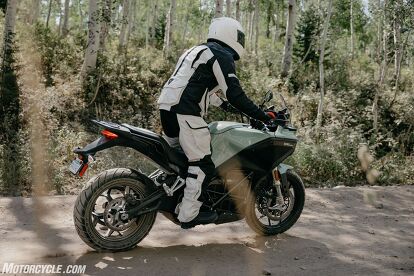
- Helmet: Arai Regent-X
- Jacket: REV’IT! Sand 4 H2O
- Airbag: Alpinestars Tech-Air 5
- Pants: REV’IT! Sand 4 H2O
- Gloves: REV’IT! Sand 4
Boots: BILT Evolution Boots
2023 Zero DSR/X Specifications | |
|---|---|
| MSRP | $24,495 |
| Motor Type | Z-Force 75-10x passively air-cooled, interior permanent magnet AC motor |
| Controller | High efficiency and power dense, 900 Amp, 3-phase AC controller with regenerative deceleration |
| Battery | Z-Force® Li-Ion intelligent integrated |
| Max Capacity | 17.3 kWh |
| Nominal Capacity | 15.2 kWh |
| Charger Type | 6.6 kW integrated |
| Charge Time | 11.6 hours (110% charged) / 10.0 hours (95% charged) |
| Charge Time W/6 kW Rapid Charger | 1.6 hours (110% charged) / 1.0 hours (95% charged) |
| Peak Horsepower (Claimed) | 100 hp (75 kW) @ 3,650 rpm |
| Torque (Claimed) | 166 ft-lb (225 Nm) |
| Final Drive | 90T / 22T, Gates Carbon Drive Moto X9™ belt, 25 mm wide |
| Front Suspension | Showa 47mm Separate Function Cartridge Forks with adjustable spring preload, compression, and rebound damping |
| Rear Suspension | Showa 46mm piston, piggy-back reservoir shock with adjustable tool-less spring preload, compression, and rebound damping |
| Suspension Travel (front and rear) | 7.48 in (190 mm) |
| Front Brake | Bosch Advanced MSC with Combined Braking (eCBS), Vehicle Hold Control (VHC) and Off-Road mode, dual J-Juan radial 4-piston calipers with radial master cylinder, 320x5mm discs |
| Rear Brake | Bosch Advanced MSC with Combined Braking (eCBS), Vehicle Hold Control (VHC) and Off-Road mode, J-Juan 2x25mm piston floating caliper, 265×4.5mm disc |
| Front Tire | Pirelli Scorpion Trail II 120/70-19 |
| Rear Tire | Pirelli Scorpion Trail II 170/60-17 |
| Front Wheel Size | 3.00 x 19 |
| Rear Wheel Size | 4.50 x 17 |
| Rake/Trail | 25.0 deg/4.3 in |
| Wheelbase | 60.0 in (1,525 mm) |
| Seat Height | 32.6 in (828 mm)/Low Seat(optional): 31.7 in (805 mm)/High Seat (optional): 34.1 in (865 mm) |
| Curb Weight | 544 lb (247 kg) (claimed) |
| Carrying Capacity | 556 lb (252 kg) |
| Range | City: 180 miles (290 km), Highway (70 mph): 85 miles (137 km), Combined: 134 miles (216 km) |
| Colors | Sage Green, White Pearl |
| Warranty | 5 years, unlimited miles on battery |
We are committed to finding, researching, and recommending the best products. We earn commissions from purchases you make using the retail links in our product reviews. Learn more about how this works.
Become a Motorcycle.com insider. Get the latest motorcycle news first by subscribing to our newsletter here.

Troy's been riding motorcycles and writing about them since 2006, getting his start at Rider Magazine. From there, he moved to Sport Rider Magazine before finally landing at Motorcycle.com in 2011. A lifelong gearhead who didn't fully immerse himself in motorcycles until his teenage years, Troy's interests have always been in technology, performance, and going fast. Naturally, racing was the perfect avenue to combine all three. Troy has been racing nearly as long as he's been riding and has competed at the AMA national level. He's also won multiple club races throughout the country, culminating in a Utah Sport Bike Association championship in 2011. He has been invited as a guest instructor for the Yamaha Champions Riding School, and when he's not out riding, he's either wrenching on bikes or watching MotoGP.
More by Troy Siahaan



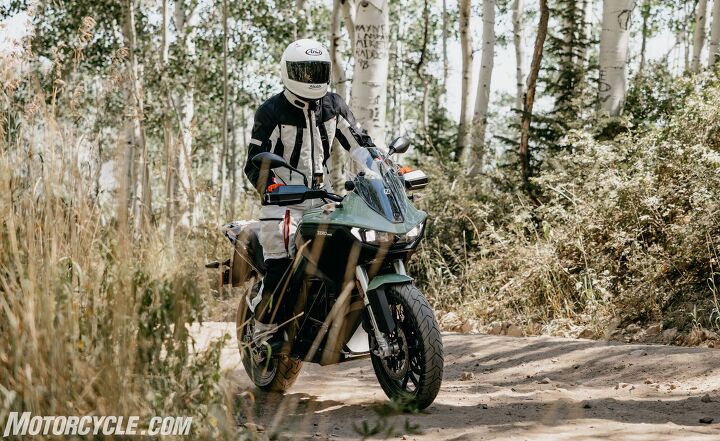































































































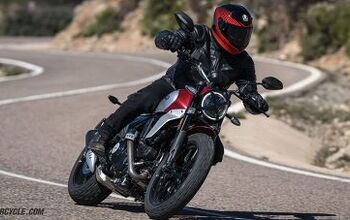

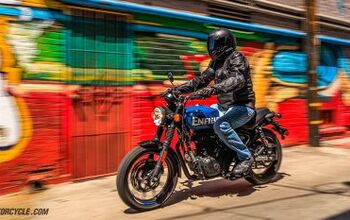
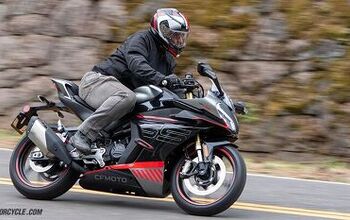


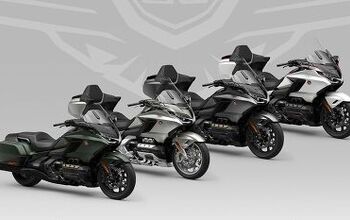







Comments
Join the conversation
"This is just the bike I was waiting for!" Said nobody ever. The price makes it even funnier.
It's all about the range. Nothing more than a $25K virtue signaling pipe dream-